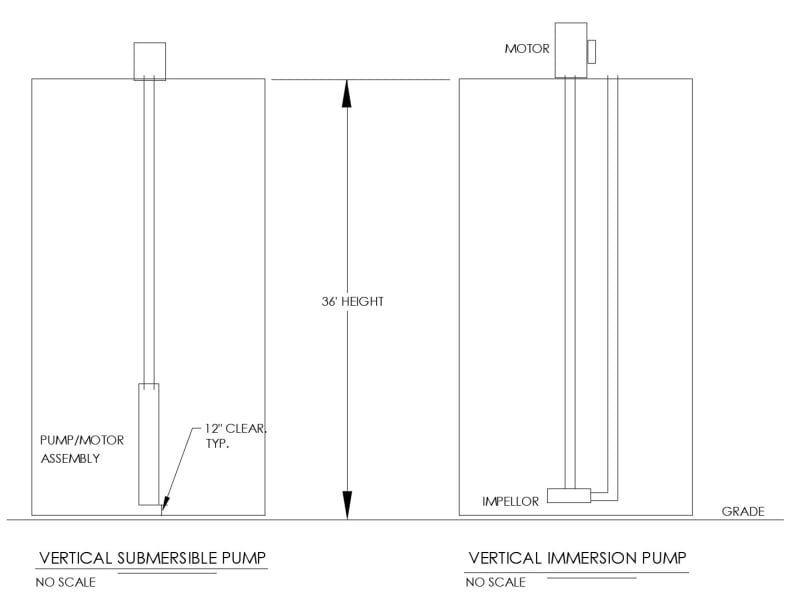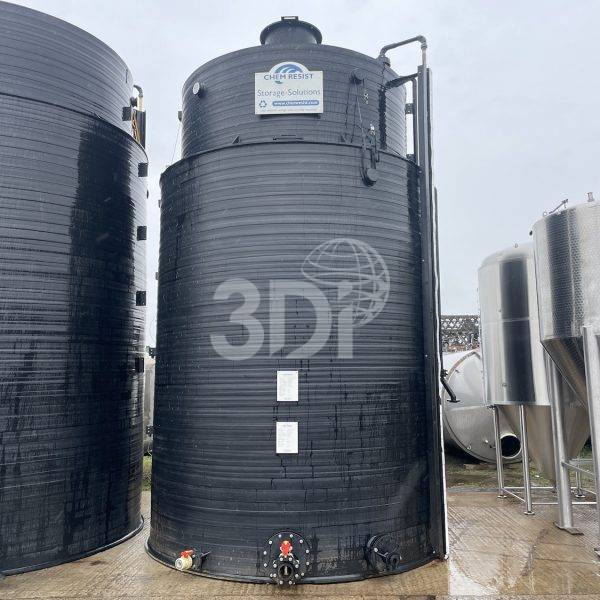We have a hospital project where the architect has changed our tanks from (2) 15,000 gallon tanks (22'H) to (1) 30,000 gallon tank (36'H). Due to other reasons, the available area has shrunk.
The change has generated (2) problems which have me between a rock and a hard place.
#2 diesel, in a tropical environment. Double wall, NFPA 30 and UL142 compliant Fuel tank serves (3) 100 GPH generators, and a Heating Hot Water boiler. Storage capacity is based up 96 hours run-time for all hardware.
Problem 1: The lead players in submersible pumps (both Franklin Fueling and Red Jacket) offerings only extend to a nominal 20' of shaft length.
With my original tanks I was fine. Now, it seems that no one makes a submersible pump for diesel fuel with a longer pickup. I am not sure why.
As I look out my window, I see the well head for my water pump; which is about 325' deep. Diesel fuel has less density that H20... so I fail to understand why no one make a "deeper" submersible pump.
The only think I can think of is that they are bumping up against physics, in that you can only suck - theoretically - 30'; like for an Oberdoffer gear pump. But a SUBMERSIBLE pump is -I assumed- just that. It is fully flooded at startup. Just like my well pump.
A couple pump vendors have suggested doing a tap off the side of the tank at grade and installing a "Pig Pump", as they called it. Problem is... se problem #2 below.
Problem #2: NFPA 30, para 22.11.4.2 requires "All piping connections to the tank shall be made above the maximum liquid level.
So. The dearth of an available submersible to reach 35 (or so) feet means I need to put something on grade, and NPFA 30 prevents me from tapping into the tank below the liquid level.
The only thing I can think of would be to use a grade-mounted gear pump, run the piping up the side of the tank to the top, make a u-bend, and then extend the piping down to appx 1' above the tank bottom. ASSUMING that (1) I could manually prime this system, and (2) the foot valve on the interior never fails, this should work. But if the foot valve fails, or the suction piping springs an air leak elsewhere, the system would not be self-priming, no fuel would be pumped, day tanks would empty, generators would fail, and darkness would ensue. Not good.
This can't be the first time a tall diesel tank has been used to provide fuel storage at a hospital. How do you get around this dilemma?
TIA.
The change has generated (2) problems which have me between a rock and a hard place.
#2 diesel, in a tropical environment. Double wall, NFPA 30 and UL142 compliant Fuel tank serves (3) 100 GPH generators, and a Heating Hot Water boiler. Storage capacity is based up 96 hours run-time for all hardware.
Problem 1: The lead players in submersible pumps (both Franklin Fueling and Red Jacket) offerings only extend to a nominal 20' of shaft length.
With my original tanks I was fine. Now, it seems that no one makes a submersible pump for diesel fuel with a longer pickup. I am not sure why.
As I look out my window, I see the well head for my water pump; which is about 325' deep. Diesel fuel has less density that H20... so I fail to understand why no one make a "deeper" submersible pump.
The only think I can think of is that they are bumping up against physics, in that you can only suck - theoretically - 30'; like for an Oberdoffer gear pump. But a SUBMERSIBLE pump is -I assumed- just that. It is fully flooded at startup. Just like my well pump.
A couple pump vendors have suggested doing a tap off the side of the tank at grade and installing a "Pig Pump", as they called it. Problem is... se problem #2 below.
Problem #2: NFPA 30, para 22.11.4.2 requires "All piping connections to the tank shall be made above the maximum liquid level.
So. The dearth of an available submersible to reach 35 (or so) feet means I need to put something on grade, and NPFA 30 prevents me from tapping into the tank below the liquid level.
The only thing I can think of would be to use a grade-mounted gear pump, run the piping up the side of the tank to the top, make a u-bend, and then extend the piping down to appx 1' above the tank bottom. ASSUMING that (1) I could manually prime this system, and (2) the foot valve on the interior never fails, this should work. But if the foot valve fails, or the suction piping springs an air leak elsewhere, the system would not be self-priming, no fuel would be pumped, day tanks would empty, generators would fail, and darkness would ensue. Not good.
This can't be the first time a tall diesel tank has been used to provide fuel storage at a hospital. How do you get around this dilemma?
TIA.


